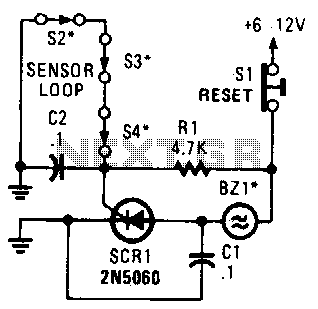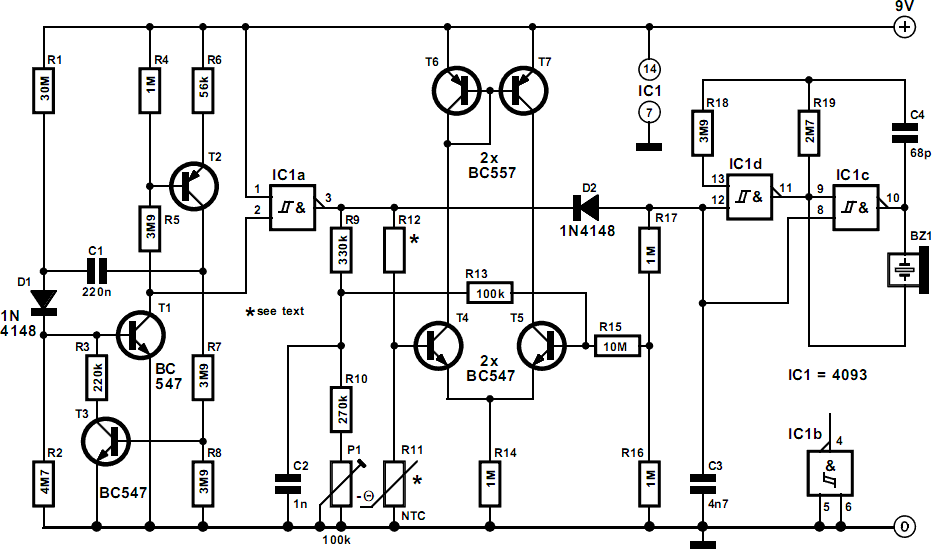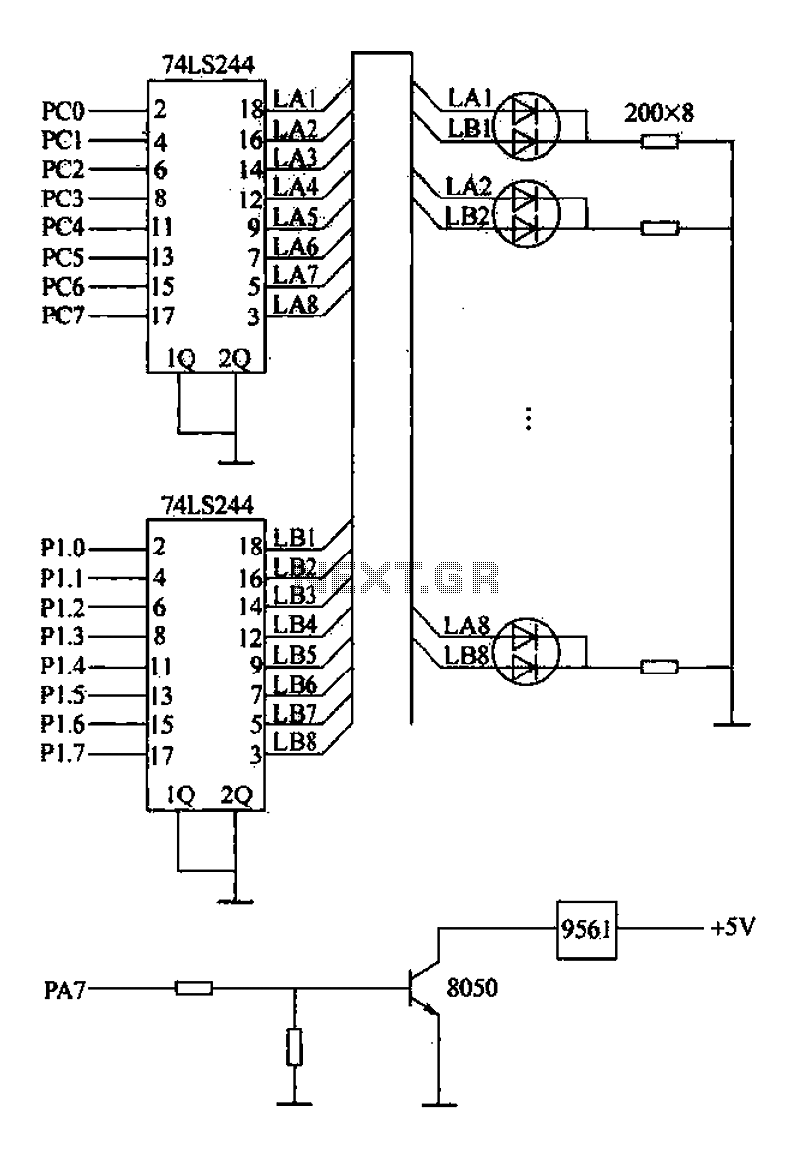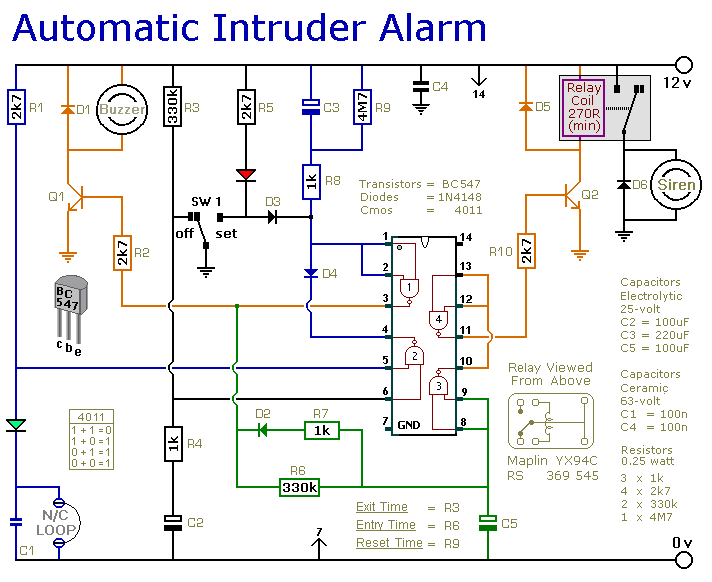
Self-arming alarm
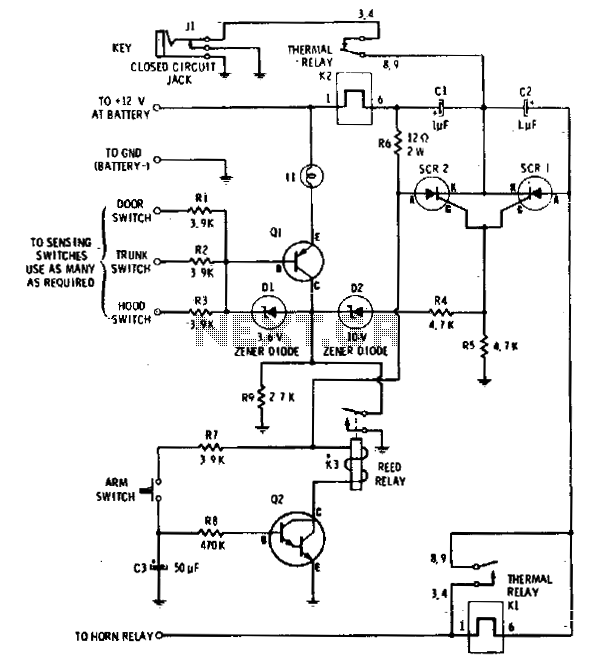
The circuit features an integrated self-arming capability. The driver turns off the ignition, presses the arm button on the Computalarm, and exits the vehicle. Within 20 seconds, the alarm arms itself automatically. The circuit is designed to detect the opening of any monitored door, the trunk lid, or the hood of the car. Once triggered, the circuit remains inactive for a 10-second delay. After this period, it activates the car's horn relay, producing horn blasts at intervals of approximately 1 to 2 seconds for one minute. Subsequently, the Computalarm automatically deactivates to conserve battery power and re-arms itself. If any door, trunk lid, or hood remains open, the alarm circuit reactivates, initiating another sequence of horn blasts. Additionally, the Computalarm includes a "key" switch that allows the driver to disarm the alarm within a 10-second window after entering the vehicle. This key switch is comprised of a closed circuit jack (J1) and a corresponding miniature plug.
The described circuit operates as a sophisticated vehicle security system, leveraging both automatic and manual control features to enhance user convenience and vehicle protection. The self-arming feature is a critical aspect, ensuring that the vehicle is secured without requiring additional action from the driver after exiting. The 20-second countdown allows the driver ample time to leave the vehicle before the system engages, providing a seamless transition to an armed state.
The detection mechanism is sensitive to the position of the vehicle's entry points, including doors, the trunk lid, and the hood. This ensures comprehensive coverage and immediate response to unauthorized access attempts. The initial 10-second dormancy period serves as a buffer, allowing the driver to close any entry points without triggering the alarm inadvertently. Upon expiration of this period, the circuit energizes the horn relay, which is responsible for producing audible alerts. The periodic horn blasts are designed to attract attention without being excessively disruptive, enhancing the effectiveness of the alarm in alerting nearby individuals to a potential breach.
The reactivation of the alarm upon detection of an ajar door or lid reinforces the system's responsiveness, ensuring that any attempts to compromise the vehicle's security are met with immediate notification. The inclusion of a manual disarm feature through the key switch provides a practical solution for the driver to deactivate the alarm quickly upon entry, particularly useful in scenarios where the alarm may be triggered unintentionally.
Overall, this circuit design exemplifies a robust approach to automotive security, integrating automated features with user-friendly controls to ensure both efficiency and effectiveness in protecting the vehicle from unauthorized access.The circuit has a built-in, self-arming feature. The driver turns off the ignition, presses the arm button on theComputalarm, and leaves the car. Within 20 seconds, the alarm arms itself—all automatically! The circuit will then detect the opening of any monitored door, the trunk lid, or the hood on the car. Once activated, the circuit remains dormant for 10 seconds. When the 10-second time delay has run out, the circuit will close the car"s horn relay and sound the horn in periodic blasts (approximately 1 to 2 seconds apart) for a period of one minute.
Then the Computalarm automatically shuts itself off (to -save your battery) and rearms If a door, the trunk lid, or the hood remains ajar, the alarm circuit retriggers and another period of horn blasts occurs. The Computalarm has a "key" switch by which the driver can disarm the alarm circuit within a 10-second period after he enters the door.
The key switch consists of a closed circuit jack, Jl, and a mating miniature plug. 🔗 External reference
The described circuit operates as a sophisticated vehicle security system, leveraging both automatic and manual control features to enhance user convenience and vehicle protection. The self-arming feature is a critical aspect, ensuring that the vehicle is secured without requiring additional action from the driver after exiting. The 20-second countdown allows the driver ample time to leave the vehicle before the system engages, providing a seamless transition to an armed state.
The detection mechanism is sensitive to the position of the vehicle's entry points, including doors, the trunk lid, and the hood. This ensures comprehensive coverage and immediate response to unauthorized access attempts. The initial 10-second dormancy period serves as a buffer, allowing the driver to close any entry points without triggering the alarm inadvertently. Upon expiration of this period, the circuit energizes the horn relay, which is responsible for producing audible alerts. The periodic horn blasts are designed to attract attention without being excessively disruptive, enhancing the effectiveness of the alarm in alerting nearby individuals to a potential breach.
The reactivation of the alarm upon detection of an ajar door or lid reinforces the system's responsiveness, ensuring that any attempts to compromise the vehicle's security are met with immediate notification. The inclusion of a manual disarm feature through the key switch provides a practical solution for the driver to deactivate the alarm quickly upon entry, particularly useful in scenarios where the alarm may be triggered unintentionally.
Overall, this circuit design exemplifies a robust approach to automotive security, integrating automated features with user-friendly controls to ensure both efficiency and effectiveness in protecting the vehicle from unauthorized access.The circuit has a built-in, self-arming feature. The driver turns off the ignition, presses the arm button on theComputalarm, and leaves the car. Within 20 seconds, the alarm arms itself—all automatically! The circuit will then detect the opening of any monitored door, the trunk lid, or the hood on the car. Once activated, the circuit remains dormant for 10 seconds. When the 10-second time delay has run out, the circuit will close the car"s horn relay and sound the horn in periodic blasts (approximately 1 to 2 seconds apart) for a period of one minute.
Then the Computalarm automatically shuts itself off (to -save your battery) and rearms If a door, the trunk lid, or the hood remains ajar, the alarm circuit retriggers and another period of horn blasts occurs. The Computalarm has a "key" switch by which the driver can disarm the alarm circuit within a 10-second period after he enters the door.
The key switch consists of a closed circuit jack, Jl, and a mating miniature plug. 🔗 External reference

